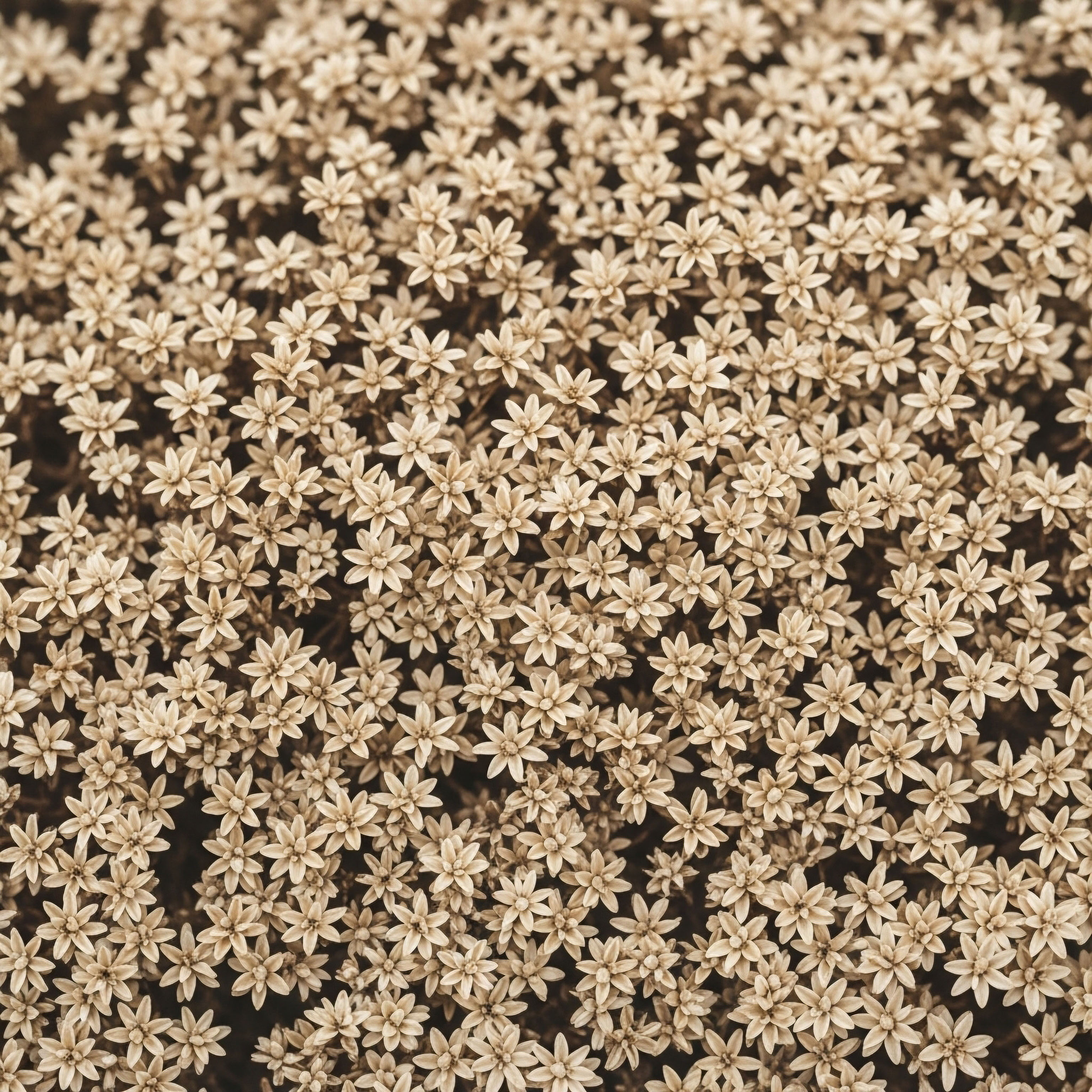

Fundamentals
The experience of watching your hair thin, particularly during a time in life defined by vitality and the potential for creating new life, presents a profound and deeply personal challenge. You are navigating a crossroads where the desire to address a visible and distressing change in your appearance intersects with the foundational priority of safeguarding your health and the health of a future child.
This intersection demands a thoughtful, informed approach. The journey begins with understanding the specific biological terrain of female pattern hair loss (FPHL) and the unique physiological context of the childbearing years.
FPHL is a process of follicular miniaturization. Within your scalp, genetically susceptible hair follicles gradually shrink over time. This shrinkage shortens the growth phase (anagen) of the hair cycle, causing each new hair to grow back finer, shorter, and less pigmented until it eventually ceases to grow altogether.
This process is influenced by a complex interplay of genetic predispositions and hormonal signals, primarily androgens. It is a gradual thinning, most often noticed as a widening of the part or a smaller ponytail.

The Central Dilemma of Treatment
The most widely recognized and clinically effective treatments for FPHL are designed to directly intervene in these hormonal and growth pathways. Topical minoxidil works as a vasodilator, aiming to enhance blood flow and prolong the anagen growth phase. Other medications, such as spironolactone or 5-alpha-reductase inhibitors, function by modulating the body’s androgenic activity to shield follicles from the miniaturizing signals.
The primary challenge arises because these mechanisms of action are incompatible with the intricate and sensitive hormonal environment of pregnancy.
A woman’s endocrine system during pregnancy undergoes a monumental and necessary recalibration, creating a sanctuary for fetal development that must be protected from external disruption.
Introducing medications that alter hormone signaling or have systemic effects can pose significant risks to a developing fetus. For this reason, the standard therapeutic options for FPHL are contraindicated for women who are pregnant, planning to become pregnant, or breastfeeding. This clinical reality shifts our focus toward a different class of solutions ∞ therapies that support the follicle and scalp environment without introducing systemic hormonal or chemical risks.

Primary Pharmacological Agents and Their Status
Understanding the limitations of conventional therapies is the first step toward exploring viable alternatives. The table below outlines the primary medications used for FPHL and clarifies their standing relative to pregnancy, illustrating why a different path is essential during this life stage.
| Medication | Mechanism of Action | Status During Childbearing Years |
|---|---|---|
| Topical Minoxidil | Enhances follicular blood flow and prolongs the growth phase. | Contraindicated during pregnancy and breastfeeding due to potential for systemic absorption and fetal harm. |
| Spironolactone | Blocks androgen receptors and reduces androgen production. | Contraindicated due to its anti-androgenic effects, which can pose risks to the development of a male fetus. |
| Finasteride/Dutasteride | Inhibit the 5-alpha-reductase enzyme, reducing the conversion of testosterone to dihydrotestosterone (DHT). | Strictly contraindicated due to their high teratogenic potential, specifically the risk of causing abnormalities in male fetal development. |
| Cyproterone Acetate | A potent anti-androgen that blocks androgen receptors. | Strictly contraindicated (Pregnancy Category X) due to the risk of feminization of a male fetus. |
This framework establishes the clear need for strategies that operate outside of these hormonal pathways. The goal becomes one of fostering the healthiest possible follicular environment through methods that are localized, non-systemic, and supportive of the body’s natural biology during this unique period.


Intermediate
With the understanding that conventional pharmacological pathways are closed during the childbearing years, the therapeutic focus pivots to a strategy of direct follicular support and environmental optimization. This approach is built on interventions that work locally at the scalp level, enhancing cellular function and providing the raw materials for healthy hair growth without systemic interference.
These methods are designed to preserve follicular health, mitigate the progression of thinning, and create the best possible conditions for hair vitality, all while respecting the delicate biological state of this life phase.

Foundational Health a Bedrock for Follicular Function
Before exploring procedural interventions, the most critical first step is to ensure the body has all the necessary resources for cellular health and tissue synthesis. Hair follicles are metabolically active and highly sensitive to systemic imbalances. A thorough evaluation of key nutritional and metabolic markers is a safe and essential starting point for any woman experiencing hair thinning, especially during the demanding childbearing years.
- Iron Status ∞ Ferritin, the body’s iron storage protein, is crucial. Low ferritin levels, even without full-blown anemia, are strongly associated with hair shedding and can exacerbate FPHL. Ensuring adequate iron stores is fundamental to supporting the energy demands of the hair follicle.
- Vitamin D ∞ This pro-hormone plays a role in creating new follicles and activating dormant ones. Deficiency is common and correcting it can be a supportive measure for overall hair cycle health.
- Zinc ∞ A vital cofactor for numerous enzymes involved in protein synthesis and cell division, zinc is integral to the formation of keratin, the primary protein that constitutes the hair shaft.
- Thyroid Function ∞ Both hypothyroidism and hyperthyroidism can cause significant hair loss. A comprehensive thyroid panel provides a clear picture of this critical metabolic regulator, which is particularly prone to fluctuations during and after pregnancy.

What Are the Viable Procedural Interventions?
Once foundational health is addressed, several procedural therapies offer localized, non-hormonal support for the hair follicle. These interventions stimulate the follicle directly, aiming to counteract the miniaturization process through distinct biological mechanisms.
These procedures work by delivering concentrated growth signals or energy directly to the scalp, awakening cellular machinery to improve follicle function.

Low Level Laser Therapy LLLT
Low-level laser therapy, delivered through caps, helmets, or combs, utilizes specific wavelengths of red light to stimulate follicular cells. This process, known as photobiomodulation, is thought to enhance mitochondrial function and increase the production of adenosine triphosphate (ATP), the primary energy currency of the cell.
By energizing the cells within the hair follicle, LLLT may help prolong the anagen (growth) phase and improve the quality of the hair produced. It is a non-invasive, pain-free treatment that can be performed at home, making it a practical option for consistent use.

Platelet Rich Plasma PRP Therapy
PRP therapy is an autologous treatment, meaning it uses a substance derived from your own body. The procedure involves drawing a small amount of your blood, processing it in a centrifuge to concentrate the platelets, and then injecting this platelet-rich plasma into the areas of thinning on the scalp.
Platelets are the body’s first responders to injury, and they are rich reservoirs of potent growth factors, including Platelet-Derived Growth Factor (PDGF), Vascular Endothelial Growth Factor (VEGF), and Epidermal Growth Factor (EGF). These signaling proteins are thought to stimulate dormant hair follicles, increase circulation to the scalp, and encourage a more robust anagen phase.

Comparing Localized Treatment Modalities
Choosing an appropriate therapy involves considering the mechanism, treatment protocol, and individual circumstances. The following table provides a comparative overview of these non-systemic options.
| Therapy | Mechanism of Action | Typical Protocol | Key Considerations |
|---|---|---|---|
| Low-Level Laser Therapy (LLLT) | Photobiomodulation enhances cellular energy (ATP) production in follicles. | Consistent use, typically every other day for 15-30 minutes. | Requires long-term commitment for maintenance. FDA-cleared devices are available for home use. |
| Platelet-Rich Plasma (PRP) | Concentrated growth factors from the patient’s own platelets stimulate follicular activity and healing. | A series of initial sessions (e.g. 3-4 treatments spaced 4-6 weeks apart), followed by maintenance sessions every 6-12 months. | Uses the body’s own biological material, minimizing risks of allergic reaction. Results can vary based on individual factors. |
| Microneedling | Creates controlled micro-injuries in the scalp to induce a wound-healing response, stimulating collagen and growth factor production. | Sessions are typically performed every 4-6 weeks. Can be used alone or to enhance penetration of topical agents. | Must be performed under sterile conditions. During childbearing years, it should be used alone, without any contraindicated topicals like minoxidil. |
These approaches collectively represent a paradigm shift away from hormonal manipulation and toward direct follicular nourishment and stimulation. They form the core of a safe and proactive strategy for managing FPHL during the unique physiological window of the childbearing years, allowing women to address their hair loss concerns without compromising their broader health objectives.


Academic
An academic exploration of female pattern hair loss during the reproductive life stage requires a deep appreciation for the dynamic endocrinology that governs this period. The management of FPHL in this context moves beyond simple treatment algorithms into a sophisticated analysis of the interplay between the Hypothalamic-Pituitary-Gonadal (HPG) axis, follicular sensitivity, and the profound physiological shifts of gestation and the postpartum period.
The central scientific challenge is to support a genetically predisposed tissue ∞ the hair follicle ∞ while navigating a systemic environment where standard therapeutic interventions are prohibited.

The Endocrinology of Hair Cycling and the Influence of Pregnancy
The human hair cycle is a finely orchestrated process with three main phases ∞ anagen (active growth), catagen (involution), and telogen (rest). In individuals with FPHL, a genetic sensitivity to androgens, particularly dihydrotestosterone (DHT), leads to a progressive shortening of the anagen phase and miniaturization of the follicle. Pregnancy introduces a dramatic, albeit temporary, alteration to this baseline state. The placenta becomes a powerful endocrine organ, producing vast quantities of estrogens, progesterone, and other hormones.
Specifically, the sustained high levels of estrogen during the second and third trimesters have a profound effect on hair cycling. Estrogen appears to prolong the anagen phase, effectively preventing hairs that would normally transition into the catagen and telogen phases from doing so.
This results in a synchronized population of follicles in the growth phase, leading to the increased hair volume and thickness many women experience during pregnancy. It is a temporary state of reprieve from the underlying mechanics of FPHL.
The postpartum period reveals the underlying follicular state, as the abrupt withdrawal of placental hormones triggers a massive, synchronized shift of follicles into the telogen phase.
This phenomenon, known as telogen effluvium, results in the significant hair shedding experienced by many women two to four months after childbirth. In a woman without FPHL, the follicles will cycle back into the anagen phase and hair density typically recovers.
In a woman with the genetic predisposition for FPHL, however, this massive shedding event can unmask or accelerate the underlying condition. The newly emerging anagen hairs are subject to the baseline androgenic influence, and many will emerge miniaturized, leading to a net loss of visible density that persists long after the postpartum shed has resolved.

How Do Non Hormonal Interventions Exert Their Effects?
Given the contraindication of hormonal agents, the focus shifts to paracrine and autocrine signaling within the dermal papilla and follicular stem cell niche. Procedural interventions like PRP and LLLT are attempts to favorably modulate this microenvironment.

Mechanistic Underpinnings of Platelet-Rich Plasma
The therapeutic rationale for PRP is grounded in its high concentration of alpha-granule-derived growth factors. When injected into the scalp, these platelets release a cascade of signaling molecules. Key among them are:
- Vascular Endothelial Growth Factor (VEGF) ∞ Promotes angiogenesis, the formation of new blood vessels, which improves circulation and nutrient delivery to the dermal papilla.
- Platelet-Derived Growth Factor (PDGF) ∞ A potent mitogen that stimulates the proliferation of dermal papilla cells, which are critical for regulating hair growth.
- Transforming Growth Factor-beta (TGF-β) ∞ Plays a complex, dual role. While some isoforms can promote catagen entry, others are involved in maintaining the follicular stem cell niche. The balance is critical.
- Insulin-like Growth Factor 1 (IGF-1) ∞ A key regulator of the cell cycle that helps maintain the anagen phase.
The collective action of these factors is hypothesized to counteract the pro-apoptotic and anti-proliferative signals that drive follicular miniaturization in FPHL. It is a direct biological appeal to the follicle to remain in an active, productive state.

The Cellular Basis of Low Level Laser Therapy
LLLT operates on a different, yet complementary, principle of photobiomodulation. The primary chromophore (light-absorbing molecule) for red light in human cells is believed to be Cytochrome C Oxidase, a key component of the mitochondrial electron transport chain.
The absorption of photonic energy is thought to upregulate this enzyme’s activity, leading to increased ATP production, a burst of reactive oxygen species (which at low levels can act as signaling molecules), and the release of nitric oxide.
This cascade can trigger the activation of transcription factors like NF-κB, ultimately leading to increased cell proliferation and a shift away from apoptosis. The effect is an enhancement of cellular metabolism, providing the energy required for the demanding process of hair synthesis and prolonging the anagen phase.
These non-systemic, localized therapies represent the frontier of FPHL management during the childbearing years. They are predicated on a deep understanding of cellular biology and aim to create a supportive microenvironment for the hair follicle, offering a scientifically grounded path forward when hormonal avenues are closed.

References
- Suchonwanit, P. Thammarucha, S. & Leerunyakul, K. (2019). Female pattern hair loss ∞ therapeutic update. Journal of dermatological treatment, 30 (7), 659 ∞ 666.
- American Academy of Dermatology Association. (2022). Thinning hair and hair loss ∞ Could it be female pattern hair loss?. Retrieved from AAD.org.
- Ho, C. H. Zito, P. M. (2021). Male and female pattern hair loss ∞ Treatable and worth treating. Cleveland Clinic Journal of Medicine, 88 (3), 173-181.
- Cleveland Clinic. (2023). Hair Loss in Women. Retrieved from Cleveland Clinic’s Health Library.
- Glasziou, P. & Shadforth, S. (2019). Female pattern hair loss. Australian Journal of General Practice, 48 (8), 514-518.

Reflection
You have now explored the intricate biology of hair, the specific challenge of FPHL, and the landscape of safe therapeutic options available during the childbearing years. This knowledge is more than a collection of facts; it is the foundation for a new perspective.
It allows you to reframe this journey from one of passive concern to one of active, informed partnership with your own body. The path forward is one of strategic support, nurturing the follicular environment while honoring the profound physiological processes of this unique life stage.
Consider the rhythm of your own life and your personal health goals. The decision to pursue a particular therapy is deeply individual, balancing practicality, expectation, and a personal definition of well-being. The information presented here is a map, but you are the navigator. This understanding empowers you to engage in a meaningful dialogue with your healthcare providers, to ask targeted questions, and to co-create a plan that feels right for you.
The seasons of a woman’s life are each defined by their own unique hormonal signature. The approach during these childbearing years is one of preservation and support. By focusing on non-hormonal, localized therapies, you are making a choice that aligns with both your desire for healthy hair and the remarkable journey of creating life. This is a period of conscious, deliberate care, and the choices you make now are an investment in your long-term vitality.

Glossary

female pattern hair loss

childbearing years

follicular miniaturization

spironolactone

minoxidil

hair loss

low-level laser therapy

platelet-rich plasma

vascular endothelial growth factor

growth factor

female pattern hair

anagen phase

telogen effluvium

follicular stem cell niche




